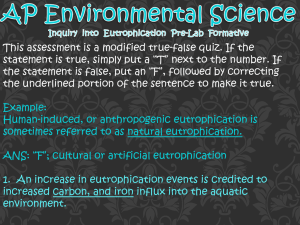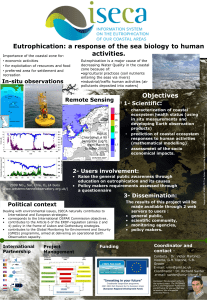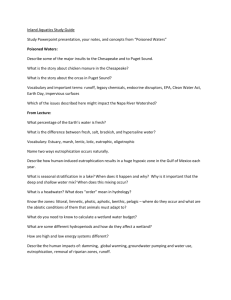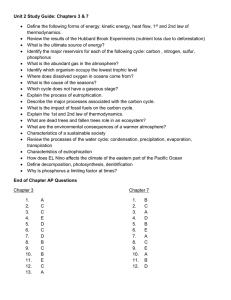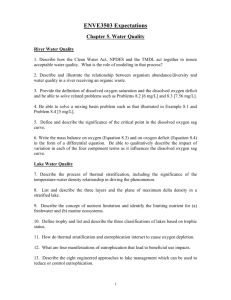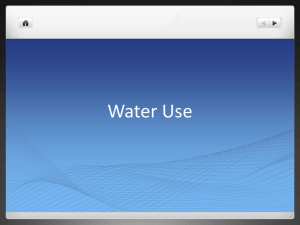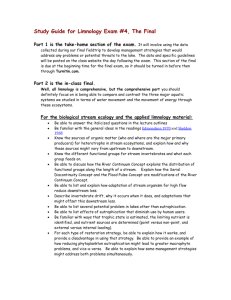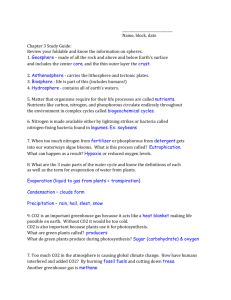WRI POLICY NOTE E H
advertisement
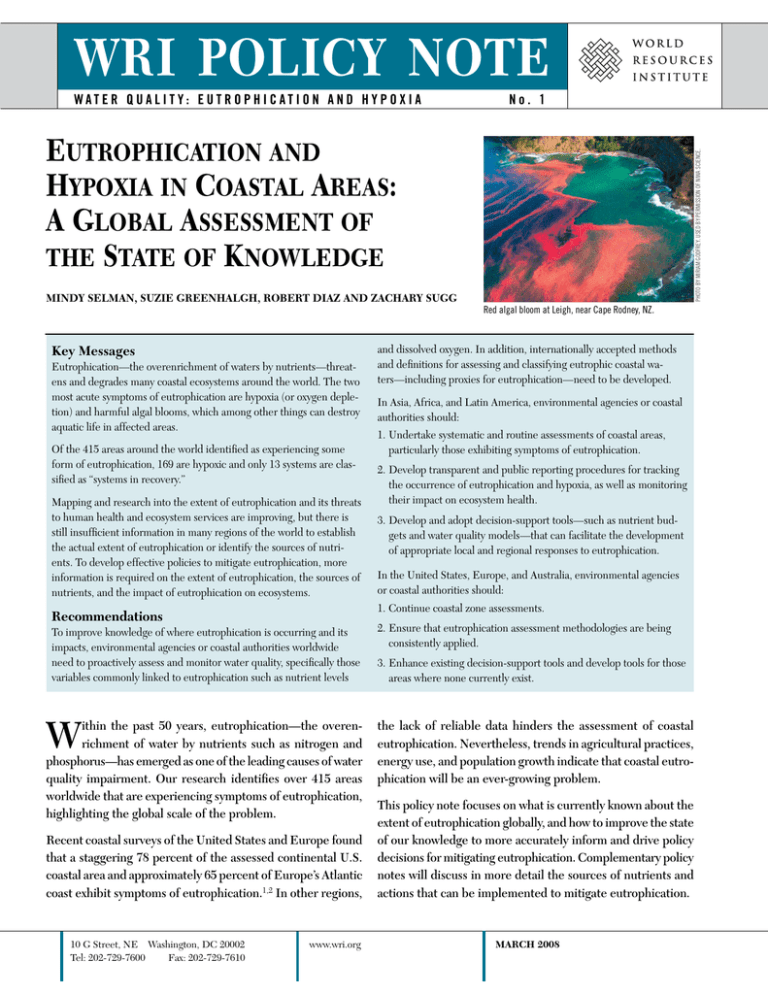
WRI POLICY NOTE WATER QUALITY: EUTROPHICATION AND HYPOXIA No. 1 PHOTO BY MIRIAM GODFREY. USED BY PERMISSION OF NIWA SCIENCE. EUTROPHICATION AND HYPOXIA IN COASTAL AREAS: A GLOBAL ASSESSMENT OF THE STATE OF KNOWLEDGE MINDY SELMAN, SUZIE GREENHALGH, ROBERT DIAZ AND ZACHARY SUGG Red algal bloom at Leigh, near Cape Rodney, NZ. Key Messages Eutrophication—the overenrichment of waters by nutrients—threatens and degrades many coastal ecosystems around the world. The two most acute symptoms of eutrophication are hypoxia (or oxygen depletion) and harmful algal blooms, which among other things can destroy aquatic life in affected areas. Of the 415 areas around the world identified as experiencing some form of eutrophication, 169 are hypoxic and only 13 systems are classified as “systems in recovery.” Mapping and research into the extent of eutrophication and its threats to human health and ecosystem services are improving, but there is still insufficient information in many regions of the world to establish the actual extent of eutrophication or identify the sources of nutrients. To develop effective policies to mitigate eutrophication, more information is required on the extent of eutrophication, the sources of nutrients, and the impact of eutrophication on ecosystems. In Asia, Africa, and Latin America, environmental agencies or coastal authorities should: 1. Undertake systematic and routine assessments of coastal areas, particularly those exhibiting symptoms of eutrophication. 2. Develop transparent and public reporting procedures for tracking the occurrence of eutrophication and hypoxia, as well as monitoring their impact on ecosystem health. 3. Develop and adopt decision-support tools—such as nutrient budgets and water quality models—that can facilitate the development of appropriate local and regional responses to eutrophication. In the United States, Europe, and Australia, environmental agencies or coastal authorities should: 1. Continue coastal zone assessments. Recommendations To improve knowledge of where eutrophication is occurring and its impacts, environmental agencies or coastal authorities worldwide need to proactively assess and monitor water quality, specifically those variables commonly linked to eutrophication such as nutrient levels W ithin the past 50 years, eutrophication—the overenrichment of water by nutrients such as nitrogen and phosphorus—has emerged as one of the leading causes of water quality impairment. Our research identifies over 415 areas worldwide that are experiencing symptoms of eutrophication, highlighting the global scale of the problem. Recent coastal surveys of the United States and Europe found that a staggering 78 percent of the assessed continental U.S. coastal area and approximately 65 percent of Europe’s Atlantic coast exhibit symptoms of eutrophication.1,2 In other regions, 10 G Street, NE Washington, DC 20002 Tel: 202-729-7600 Fax: 202-729-7610 and dissolved oxygen. In addition, internationally accepted methods and definitions for assessing and classifying eutrophic coastal waters—including proxies for eutrophication—need to be developed. www.wri.org 2. Ensure that eutrophication assessment methodologies are being consistently applied. 3. Enhance existing decision-support tools and develop tools for those areas where none currently exist. the lack of reliable data hinders the assessment of coastal eutrophication. Nevertheless, trends in agricultural practices, energy use, and population growth indicate that coastal eutrophication will be an ever-growing problem. This policy note focuses on what is currently known about the extent of eutrophication globally, and how to improve the state of our knowledge to more accurately inform and drive policy decisions for mitigating eutrophication. Complementary policy notes will discuss in more detail the sources of nutrients and actions that can be implemented to mitigate eutrophication. MARCH 2008 POLICY NOTE: Eutrophication and Hypoxia in Coastal Areas that eutrophication diminishes the ability of coastal ecosystems to provide valuable ecosystem services such as tourism, recreation, the provision of fish and shellfish for local communities, sportfishing, and commercial fisheries. In addition, eutrophication can lead to reductions in local and regional biodiversity. WHY IS EUTROPHICATION A PROBLEM? The rise in eutrophic and hypoxic events has been primarily attributed to the rapid increase in intensive agricultural practices, industrial activities, and population growth, which together have increased nitrogen and phosphorus flows in the environment. Human activities have resulted in the near doubling of nitrogen and tripling of phosphorus flows to the environment when compared to natural values.3 By comparison, human activities have increased atmospheric concentrations of carbon dioxide, the gas primarily responsible for global warming, by approximately 32 percent since the onset of the industrial age.4 Today nearly half of the world’s population lives within 60 kilometers of the coast, with many communities relying directly on coastal ecosystems for their livelihoods.7 This means that a significant portion of the world’s population is vulnerable to the effects of eutrophication in their local coastal ecosystems. Harmful Algal Blooms and Hypoxia. Two of the most acute and commonly recognized symptoms of eutrophication are harmful algal blooms and hypoxia. Before nutrients—nitrogen in particular—are delivered to coastal ecosystems, they pass through a variety of terrestrial and freshwater ecosystems, causing other environmental problems such as freshwater quality impairments, acid rain, the formation of greenhouse gases, shifts in community food webs, and a loss of biodiversity.5 Harmful algal blooms can cause fish kills, human illness through shellfish poisoning, and death of marine mammals and shore birds.8 Harmful algal blooms are often referred to as “red tides” or “brown tides” because of the appearance of the water when these blooms occur. One red tide event, which occurred near Hong Kong in 1998, wiped out 90 percent of the entire stock of Hong Kong’s fish farms and resulted in an estimated economic loss of $40 million USD.9,10 Once nutrients reach coastal systems, they can trigger a number of responses within the ecosystem. The initial impacts of nutrient increases are the excessive growth of phytoplankton, microalgae (e.g., epiphytes and microphytes), and macroalgae (i.e., seaweed). These, in turn, can lead to other impacts such as: Hypoxia, considered to be the most severe symptom of eutrophication, has escalated dramatically over the past 50 years, increasing from about 10 documented cases in 1960 to at least 169 in 2007.11,12 Hypoxia occurs when algae and other organisms die, sink to the bottom, and are decomposed by bacteria, using the available dissolved oxygen. Salinity and temperature differences between surface and subsurface waters lead to stratification, limiting oxygen replenishment from surface waters and creating conditions that can lead to the formation of a hypoxic or “dead” zone.13 • Loss of subaquatic vegetation as excessive phytoplankton, microalgae, and macroalgae growth reduce light penetration. • Change in species composition and biomass of the benthic (bottom-dwelling) aquatic community, eventually leading to reduced species diversity and the dominance of gelatinous organisms such as jellyfish. • Coral reef damage as increased nutrient levels favor algae growth over coral larvae. Coral growth is inhibited because the algae outcompetes coral larvae for available surfaces to grow. Two of the most well-known hypoxic areas are the Gulf of Mexico and the Black Sea. The Gulf of Mexico has a seasonal hypoxic zone that forms every year in late summer. Its size varies; in 2000, it was less than 5,000 km2, while in 2002 it was approximately 22,000 km2 (or the size of the U.S. state of Massachusetts). While the economic consequences of the Gulf of Mexico dead zone are still unclear, concern over its increasing size led to the formation of the Mississippi River/Gulf of Mexico Watershed Nutrient Task Force in 1997 to develop a strategy to reduce the five-year running average areal extent of the Gulf of Mexico hypoxic zone to less than 5,000 km2. • A shift in phytoplankton species composition, creating favorable conditions for the development of nuisance, toxic, or otherwise harmful algal blooms. • Low dissolved oxygen and formation of hypoxic or “dead” zones (oxygen-depleted waters), which in turn can lead to ecosystem collapse. 6 The scientific community is increasing its knowledge of how eutrophication affects coastal ecosystems, yet the long-term implications of increased nutrient fluxes in our coastal waters are currently not entirely known or understood. We do know March 2008 The Black Sea, which was once the largest dead zone in the world, had 26 commercially viable fish species in the 1960s but 2 WORLD RESOURCES INSTITUTE POLICY NOTE: Eutrophication and Hypoxia in Coastal Areas only five species by the 1980s.14 The growth of the Black Sea hypoxic zone was attributed to the intensification of agriculture in the former Soviet Union. It has been “in recovery” since the economic collapse of Eastern Europe in the 1990s, which resulted in significant reductions in fertilizer use. Atmospheric sources of nitrogen are also recognized as a significant contributor of nutrients in coastal areas.16 Nitrogen from fossil fuel combustion and volatilization from fertilizers and manure is released into the atmosphere and redeposited on land and in water by wind, snow, and rain. In the Chesapeake Bay in the mid-Atlantic region of the eastern United States, atmospheric sources of nitrogen account for a third of all controllable nitrogen that enters the Bay; similarly, in the Baltic Sea in Europe, atmospheric nitrogen accounts for a fourth of all controllable nitrogen. WHAT ARE THE SOURCES OF NUTRIENTS? Agriculture, human sewage, urban runoff, industrial effluent, and fossil fuel combustion are the most common sources of nutrients delivered to coastal systems. Among regions, there are significant variations in the relative importance of each nutrient source. For example, in the United States and the European Union, agricultural sources (particularly animal manure and commercial fertilizers) are generally the primary contributors to eutrophication, while sewage and industrial discharges, which usually receive some treatment prior to discharge, are a secondary source. However, in Latin America, Asia, and Africa, wastewater from sewage and industry are often untreated and may often be the primary contributors to eutrophication. It is currently estimated that only 35 percent of wastewater in Asia is treated, 14 percent in Latin America and the Caribbean, and less than 1 percent in Africa.15 March 2008 WHERE ARE THE GLOBAL EUTROPHIC AND HYPOXIC AREAS? Our research identified 415 eutrophic and hypoxic coastal systems worldwide (Figure 1).17 Of these, 169 are documented hypoxic areas, 233 are areas of concern, and 13 are systems in recovery. The coastal areas reported as experiencing eutrophication are steadily growing. This is because of the increasing prevalence of eutrophication and advances in identifying and reporting eutrophic conditions. 3 WORLD RESOURCES INSTITUTE POLICY NOTE: Eutrophication and Hypoxia in Coastal Areas The first comprehensive list of hypoxic zones was compiled by Diaz and Rosenberg in 1995 and identified 44 documented hypoxic areas.18 Twelve years later, there are 169 documented hypoxic areas, a nearly four-fold increase. The list of hypoxic areas assembled by Diaz was compiled from scientific literature and identified the majority of documented hypoxic areas. However, the list did not include areas with suspected—but not documented—hypoxic events or systems that suffer from other impacts of eutrophication such as nuisance or harmful algal blooms, loss of subaquatic vegetation, and changes in the structure of the benthic aquatic community (for example, decline in biomass, changes in species composition, and loss of diversity). tion, the data that do exist are often inconsistent in terms of parameters measured, indicators used, and the scale at which data are reported. Given the state of global data, the number of eutrophic and hypoxic areas around the world is expected to be greater than the 415 listed here. The most underrepresented region is Asia. Asia has relatively few documented eutrophic and hypoxic areas despite large increases in intensive farming methods, industrial development, and population growth over the past 20 years. Africa, Latin America, and the Caribbean also have few reliable sources of coastal water quality data, making it difficult to assess the true level of eutrophication. The scale at which data for eutrophic areas are reported varies greatly. For example, red tides and other eutrophic events are frequently recorded in the South China Sea, Yellow Sea, and Bohai Sea. However, the actual extent of eutrophication or hypoxia in specific bays and estuaries within these systems is unknown. Therefore, these areas are coarsely recorded in Figure 1 and most likely represent several affected bays and estuaries along the Chinese coast. Conversely, within the well-studied Chesapeake Bay system, there are 12 distinct and documented eutrophic and hypoxic zones. To supplement this list of hypoxic zones, the authors undertook an extensive literature review to catalog systems experiencing any symptoms of eutrophication, including—but not limited to—hypoxia.19 The eutrophic areas identified were categorized as: • Documented hypoxic areas. Areas with scientific evidence that hypoxia was caused, at least in part, by nutrient overenrichment. This category includes the most recent list of hypoxic areas compiled by Diaz (excluding hypoxia caused by natural upwelling of nutrients), as well as some additional systems identified by our research.20 The United States, European Union, and Australia—all of which have each undertaken comprehensive coastal surveys in the past five years—have the most comprehensive coastal data on eutrophication. However, even within the United States and Europe, the quality, consistency, and availability of water quality data varies. For example, in Europe, the coastal survey coordinated through the Commission for the Protection of the Marine Environment of the North-East Atlantic (OSPAR) highlighted the variability in quality and availability of monitoring data among the various European countries.21 Several coastal areas lacked dissolved oxygen measures and many of the secondary effects of eutrophication, such as fish kills and changes in the benthic community, were not extensively monitored. The U.S. National Oceanic and Atmospheric Agency’s (NOAA) National Estuarine Eutrophication Assessment program, which conducted national eutrophication surveys in 1999 and 2007, experienced data issues similar to those encountered in the OSPAR survey. Of the 141 U.S. estuaries evaluated in 2007, 30 percent lacked adequate data for assessing their eutrophication status. • Areas of concern. Systems that exhibit effects of eutrophication, such as elevated nutrient levels, elevated chlorophyll a levels, harmful algal blooms, changes in the benthic community, damage to coral reefs, and fish kills. These systems are impaired by nutrients and are possibly at risk of developing hypoxia. Some of the systems classified as areas of concern may already be experiencing hypoxia, but lack conclusive scientific evidence of the condition. • Systems in recovery. Areas that once exhibited low dissolved oxygen levels and hypoxia, but are now improving. For example, the Black Sea once experienced annual hypoxic events, but is now in a state of recovery. Others, like Boston Harbor in the United States and the Mersey Estuary in the United Kingdom, also have improved water quality resulting from better industrial and wastewater controls. WHERE ARE THE DATA INCONSISTENCIES AND GAPS? Most systems identified as hypoxic or eutrophic also lack detailed data on the sources of nutrient impairments and the relative contribution of each source. Some systems that have developed detailed nutrient budgets include the Chesapeake The actual extent and prevalence of eutrophication in many regions is only beginning to be studied. As a consequence, data do not exist or are not publicly available for many areas that may be suffering from the effects of eutrophication. In addi- March 2008 4 WORLD RESOURCES INSTITUTE POLICY NOTE: Eutrophication and Hypoxia in Coastal Areas Bay, Baltic Sea, Black Sea, Gulf of Mexico (Mississippi-Atchafalaya plume), and Tampa Bay. The absence of detailed nutrient budgets for the majority of eutrophic and hypoxic systems around the world highlights the lack of concerted research efforts in these areas, compromising the ability to effectively address and manage nutrient overenrichment. • Regional and international online information portals for compiling and sharing water quality information and research; HOW DO WE IMPROVE THE STATE OF KNOWLEDGE? Implementation of these tools is especially needed to estimate coastal impacts and target appropriate policy responses in countries and regions where actual monitoring data are scarce. • Nutrient loss estimation tools; and • Tools to help assess the effectiveness of alternative scenarios for reducing nutrient inputs. To better assess the global, regional, and local extent of eutrophication, we need more and better data. Improving our knowledge of where eutrophication is occurring, the sources contributing to the problem, and the effects of eutrophication on marine ecosystems and human communities ultimately influences the ability of policy-makers to decide where and how resources can be used most effectively to address eutrophication. Eutrophication is an issue that requires greater attention by governments and society in general. Left untouched, it may have dire consequences for many ecosystems, the food webs that they support, and the livelihoods of the populations that depend on them. To get a better grasp on the immediate and long-term consequences of eutrophication, we need more resources and better information. Improving our knowledge and information on eutrophication is the first step in developing robust policy measures to begin reversing or halting its impacts. Closing the knowledge gap requires increased and improved water quality monitoring and assessment of estuarine and coastal waters. Without this information, communities cannot effectively manage coastal ecosystems and address land-based sources of pollution. Specifically, time series monitoring data—on nutrient levels, chlorophyll a (as an indicator of the presence of phytoplankton), and dissolved oxygen—as well as eutrophication response parameters—such as loss of subaquatic vegetation, fish kills, and algal blooms—are needed to evaluate the extent and degree of eutrophication. Moreover, widespread use and adoption of methods to classify and define eutrophic waters (such as the ones developed by NOAA and OSPAR) are needed to increase the transparency, consistency, and comparability of water quality information. For example, currently no common definition of “hypoxia” exists and the interpretation of what is hypoxic can vary widely from place to place. ABOUT THE AUTHORS Mindy Selman is a senior associate in the People and Ecosystems Program of the World Resources Institute. Ph: +1-202-729 7644. Email: mselman@wri.org Suzie Greenhalgh is a senior economist at Landcare Research New Zealand Ltd. Ph: +64-9-574 4132. Email: greenhalghs@landcareresearch.co.nz Robert Diaz is a professor of marine science at the College of William and Mary, Virginia Institute of Marine Science. Ph: +1-804-684 7364. Email: diaz@vims.edu Zachary Sugg is a research analyst with the People and Ecosystems Program of the World Resources Institute. Ph: +1-202-729 7605. Email: zsugg@wri.org In countries or regions where robust and systematic monitoring programs are unlikely to be implemented due to limited resources, it would be beneficial to develop credible and consistent proxies for water quality (such as turbidity or sulfide smell) that could be used to identify likely eutrophic areas. ACKNOWLEDGMENTS The authors are grateful for the contributions provided by Donald Anderson, James Galloway, Paul Harrison, Laurence Mee, Qian Yi, and Nancy Rabalais, who served on a WRI eutrophication advisory panel. The authors would also like to acknowledge Kersey Sturdivant for his research assistance in identifying areas of eutrophication. In addition, the authors thank Craig Hanson, Lauretta Burke, Amy Cassara, Dan Tunstall, Laurence Mee, and James Galloway for reviewing earlier drafts of this paper. Finally, we extend our thanks to the Linden Trust for Conservation and the David and Lucile Packard Foundation for their support of this research. Finally, decision support tools that enable researchers and policy-makers to formulate appropriate responses to eutrophication need to be continually developed and more widely adopted by local and regional entities. Such tools include: • Watershed models to assess nutrient delivery and ecosystem impacts; • Nutrient balance assessments to determine the sources of nutrients and relative contribution of each source; March 2008 5 WORLD RESOURCES INSTITUTE POLICY NOTE: Eutrophication and Hypoxia in Coastal Areas NOTES 15. See Howarth, R. and K. Ramakrrshna. 2005. “Nutrient Management.” In K. Chopra, R. Leemans, P. Kumar, and H. Simons, eds. Ecosystems and Human Wellbeing: Policy Responses. Volume 3 of the Millennium Ecosystem Assessment (MA). Washington, DC: Island Press. 16. See Spokes, L. J., and T. D. Jickells. 2005. “Is the atmosphere really an important source of reactive nitrogen to coastal waters?” Continental Shelf Research 25: 2022–2035. 17. Region-specific maps as well as the data used to create these maps is made available on WRI’s website, www.wri.org/project/water-quality. 18. See Diaz, R. and R. Rosenburg. 1995. “Marine benthic hypoxia: a review of its ecological effects and the behavioural responses of benthic macrofauna.” Oceanography and Marine Biology: an Annual Review 33: 245–303. 1. See Bricker, S. B., Longstaff, W. Dennison, A. Jones, K. Boicourt, C. Wicks, and J. Woerner. 2007. Effects of Nutrient Enrichment in the Nation’s Estuaries: A Decade of Change. NOAA Coastal Ocean Program Decision Analysis Series No. 26. Silver Spring, MD: National Centers for Coastal Ocean Science. Online at: http://ccma.nos.noaa.gov/publications/eutroupdate/ 2. See OSPAR Commission. 2003. OSPAR integrated report 2003 on the eutrophication status. London, U.K.: OSPAR. 3. See Howarth, R. and K. Ramakrrshna. 2005. “Nutrient Management.” In K. Chopra, R. Leemans, P. Kumar, and H. Simons, eds. Ecosystems and Human Wellbeing: Policy Responses. Volume 3 of the Millennium Ecosystem Assessment (MA). Washington, DC: Island Press. 4. See National Oceanic and Atmospheric Administration (NOAA). “Global Warming: Frequently asked questions.” Available at: http://lwf.ncdc. noaa.gov/oa/climate/globalwarming.html. (accessed January 15, 2008) 5. See Galloway, J.N, J.D. Aber,, J.W. Erisman, S.P. Seitzinger, R.W. Howarth, E.B. Cowling, and B.J. Cosby. 2003. “The Nitrogen Cascade.” Bioscience 53( 4): 341–356 6. For a discussion on the impacts of eutrophication on coastal ecosystems, see Mee, L. 2006. “Reviving Dead Zones.” Scientific American 295 (5): 79–85. 7. See: UN Chronicle Online Edition. “Risks, Untreated Sewage Threatens Seas, Coastal Population.” http://www.un.org/Pubs/chronicle/2003/ issue1/0103p39.html. (accessed January 15, 2008) 8. Harmful algal blooms refer to several species of algae that produce toxins that are harmful to aquatic life. See Anderson, D. M., P. M. Gilbert, and J. M. Burkholder. 2002. “Harmful Algal Blooms and Eutrophication: Nutrient Sources, Composition, and Consequences.” Estuaries 25 (4b): 704–726. 9. See: Terra Daily Online Edition. “Hong Kong red tide spreads,” (June 10, 2007). http://www.terradaily.com/reports/Hong_Kong_Red_Tide_ Spreads_999.html (accessed February 8, 2008). 10. See Lu, S., and I. J. Hodgkiss. 2004. “Harmful algal bloom causative collected from Hong Kong waters.” Hydrobiologia.512(1-3): 231-238 11. Hypoxia is generally defined as having a dissolved oxygen concentration of 2.0 milligrams per liter or less. 12. See Diaz, R. J., J. Nestlerode, and M. L. Diaz. 2004. “A global perspective on the effects of eutrophication and hypoxia on aquatic biota.” In G. L. Rupp and M. D. White, eds. Proceedings of the 7th International Symposium on Fish Physiology, Toxicology, and Water Quality, Tallinn, Estonia, May 12-15, 2003. Athens, Georgia: U.S. Environmental Protection Agency, Ecosystems Research Division (EPA 600/R-04/049). 13. See Rabalais, N. N., and R. E. Turner. 2001. Coastal hypoxia consequences for living resources and ecosystems. Washington, DC: American Geophysical Union. 14. See Europe Now|Next. “Is the Black Sea recovering?” http://www.europe.culturebase.net/contribution.php?media=307 (accessed December 30, 2008) ABOUT WRI The World Resources Institute is an environmental think tank that goes beyond research to find practical ways to protect the Earth and improve people’s lives. Our mission is to move human society to live in ways that protect the Earth’s environment and its capacity to provide for the needs and aspirations of current and future generations. 19. The primary data sources include: • Diaz, R. J., J. Nestlerode, and M. L. Diaz. 2004. “A global perspective on the effects of eutrophication and hypoxia on aquatic biota.” In G. L. Rupp and M. D. White, eds. Proceedings of the 7th International Symposium on Fish Physiology, Toxicology, and Water Quality, Tallinn, Estonia, May 12-15, 2003. Athens, Georgia: U.S. Environmental Protection Agency, Ecosystems Research Division (EPA 600/R-04/049). • Bricker, S. B., Longstaff, W. Dennison, A. Jones, K. Boicourt, C. Wicks, and J. Woerner. 2007. Effects of Nutrient Enrichment in the Nation’s Estuaries: A Decade of Change. NOAA Coastal Ocean Program Decision Analysis Series No. 26. Silver Spring, MD: National Centers for Coastal Ocean Science. Online at: http://ccma.nos.noaa.gov/publications/eutroupdate/. • OSPAR Commission. 2003. OSPAR integrated report 2003 on the eutrophication status. London, UK: OSPAR. • OzEstuaries. 2005. “Anoxic and Hypoxic Events.” Online at: http://www. ozestuaries. org/indicators/anoxic_hypoxic_events.jsp (August, 2005). • United Nations Environment Program (UNEP). 2006. Challenges to International Waters – Regional Assessments in a Global Perspective. Nairobi, Kenya: United Nations. 20. See Diaz, R. J., J. Nestlerode, and M. L. Diaz. 2004. “A global perspective on the effects of eutrophication and hypoxia on aquatic biota.” In G. L. Rupp and M. D. White, eds. Proceedings of the 7th International Symposium on Fish Physiology, Toxicology, and Water Quality, Tallinn, Estonia, May 12-15, 2003. Athens, Georgia: U.S. Environmental Protection Agency, Ecosystems Research Division (EPA 600/R-04/049). 21. OSPAR called for the uniform assessment of coastal waters by signatory countries. Signatory countries to the 1992 Oslo-Paris Convention for the Protection of the Marine Environment of the North-East Atlantic (OSPAR Convention) include Belgium, Denmark, France, Germany, Ireland, The Netherlands, Norway, Portugal, Spain, Sweden, and the United Kingdom. Forthcoming publications in this series include: • Eutrophication: Sources and Drivers of Nutrient Pollution • Eutrophication: A Policy Framework for Addressing Nutrient Pollution Please visit www.wri.org/publications for links to available publications. March 2008 6 WORLD RESOURCES INSTITUTE
